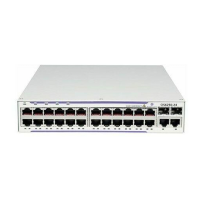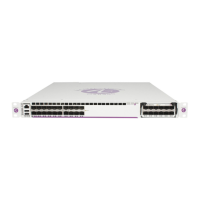QoS Policies
7210 SAS D, E, K OS Quality of Service Guide Page 67
RED Slopes
Operation and Configuration for 7210 SAS-E
NOTE: 7210 SAS-E supports SRED mechanisms and not WRED. SRED uses the average queue
lengths, queue thresholds provisioned, and drop probablility to calculate the packet’s eligibility to
be enqueued.
The committed portion of the buffer pool is exclusively used by a queue to enqueue traffic within
committed rate. Each queue provides user an option to configure high-priority RED slope and a
low-priority RED slope. The high-priority RED slope manages access to the shared portion of the
buffer pool for high-priority or in-profile packets. The low-priority RED slope manages access to
the shared portion of the buffer pool for low-priority or out-of-profile packets.
By default, the high-slope and low-slope for all the 8 queues are disabled.
Operation and Configuration for 7210 SAS-D
On 7210 SAS-D each queue provides user an option to configure 3 slopes per queue - high-priority
RED slope, a non-TCP RED slope, and a low-priority RED slope or use 2 slopes per queue - high-
priority RED slope and a low-priority RED slope. The high-priority RED slope manages access to
the shared portion of the buffer pool for high priority or in-profile packets. The low-priority RED
slope manages access to the shared portion of the buffer pool for low-priority or out-of-profile
packets. The non-TCP slope manages access to the shared portion of the buffer pool for non-TCP
packets.
Each buffer pool supports a high-priority RED slope, a non-TCP RED slope, and a low-priority
RED slope. The high-priority RED slope manages access to the shared portion of the buffer pool
for high-priority or in-profile packets. The low-priority RED slope manages access to the shared
portion of the buffer pool for low-priority or out-of-profile packets. The non-TCP slope manages
access to the shared portion of the buffer pool for non-TCP packets.
By default, the high-priority, low-priority, and non-TCP RED slopes are disabled.
When a queue depth exceeds the queue’s CBS, packets received on that queue must contend with
other queues exceeding their CBS for shared buffers. To resolve this contention, the buffer pool
uses two RED slopes to determine buffer availability on a packet by packet basis. A packet that
was either classified as high priority or considered in-profile is handled by the high-priority RED
slope. This slope should be configured with RED parameters that prioritize buffer availability over
packets associated with the low-priority RED slope. Packets that had been classified as low
priority or out-of-profile are handled by this low-priority RED slope.

